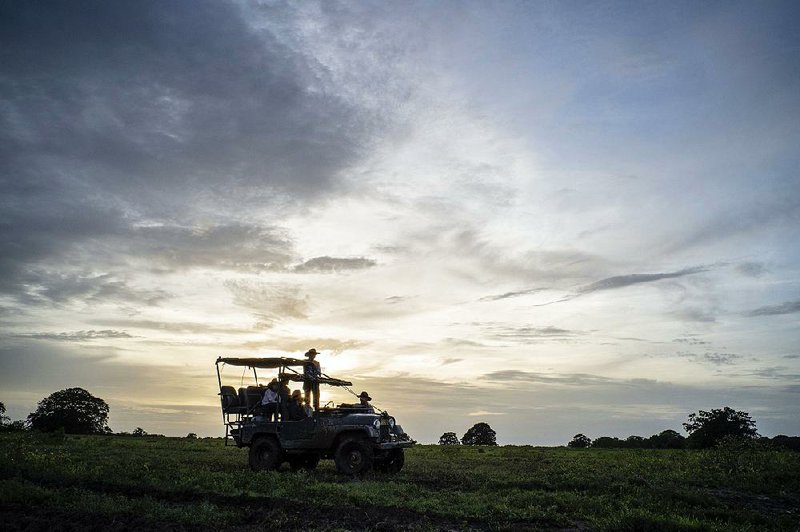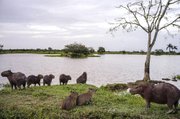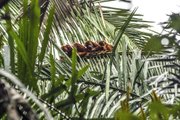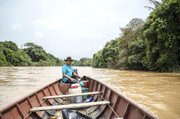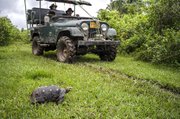The pond-side trees appeared to be turning red as flocks of scarlet ibises flew in to roost, brilliant from their bills to their toes. They dueled with egrets over the best perches, squawking raucously. A squadron of chubby capybaras -- the world's largest rodents -- idled in the muddy shallows before suddenly charging off, churning the water, lunging and splashing.
As darkness fell, the birds settled in, the wind died and the place became tranquil. A caiman slipped quietly into the muddy water. The first stars appeared low in the eastern sky, and night fell over the Colombian llanos.
This vast region -- extending from the Andes to the Orinoco River, and Venezuela beyond, is known as the Llanos Orientales -- or eastern plains. It is a broad, flat savanna split by slow, muddy rivers lined with gallery forests. In the rainy season, from May to October, tropical downpours turn muddy trickles into rivers, plains to lakes, and dry ground to mud. In the dry season, lakes shrink, rivers drop and the land becomes parched and sun-baked. It all combines to create an otherworldly landscape, teeming with wildlife.
"The plains surrounding us seemed to reach the sky, and looked to us like an ocean covered with seaweed," wrote Prussian naturalist Alexander von Humboldt, who crossed the llanos in 1800. "Sky and land merged."
The landscape and wildlife are increasingly attracting tourists to places like Juan Solito, an eco-lodge founded in 1999 by Nelson Barragan. It is just across the silty Ariporo River from Hato La Aurora, a 37,000-acre ranch that belongs to the extended Barragan family.
Tourists stay at Juan Solito and spend their days exploring the ranch, which is managed as a wildlife reserve through Colombia's Ministry of Environment and Sustainable Development.
Barragan is a pure llanero, as natives of the region are known. He sometimes plays the lively yet plaintive llanero music for guests, on the harp or the four-stringed cuatro. During the wet season, he rides alongside the other vaqueros to round up the cattle.
On my first morning, Barragan outlined the options for exploring the area. Over several cups of tinto, the strong black coffee that keeps Colombia caffeinated, we came up with a three-day plan -- a wildlife safari, a fishing expedition and a search for snakes.
ACROSS THE RIVER
Later that morning, Giovanni Castilla, my guide, and I ferried across the river in a large, wood-planked canoe. Along the riverbank, leaf-cutter ants rambled industriously, looking like a fleet of tiny rusty boats with oversize green sails. A roadside hawk perched in a riverside tree. Parked in the shade was a Toyota pickup, tricked out safari-style with padded bench seats in the stake-side bed. I hopped in back and we rolled out onto the open plains on a rutted dirt road.
Wildlife was abundant and conspicuous. A barefaced ibis foraged through the grass as a crested caracara hunted for turtle eggs along the mud bank of a small creek. Deer grazed in the near distance, and beyond, next to a small muddy pond, a pair of jabirus -- large, ridiculous-looking storks with red, pelican-like pouches.
At a larger pond just down the road, a dozen spectacled caimans lounged in the shallows, and a long-toed bird called a wattled jacana waded alongside a roseate spoonbill. A pair of Orinoco geese tended goslings, and two dozen capybaras sat half-submerged, looking docile, some with mud caked across their backs. Profiled on a sandy bench a few feet above the rest of the plain, four pairs of burrowing owls stood by their dens.
On the second morning, Castilla and I traveled to a far corner of the ranch to do some fishing. As we drove over the plains, a lesser yellow-headed vulture soared overhead, and a great black hawk flew by, one talon clutching a large iguana by the neck. Another big lizard darted shrub-to-shrub over the plain. It was darker and stockier than an iguana -- a golden tegu.
We left the truck at an impassable creek crossing and set off walking through a patch of jungle. This corner of the ranch felt wilder. It was easy to imagine jaguars roaming the land, and they do.
31 JAGUARS IDENTIFIED
In April 2017, Nelson's brother Jorge Barragan and Brigitte Baptiste, the director of Colombia's Humboldt Institute, saw two large jaguars resting in a swamp in the middle of the day. Using wildlife cameras, Jorge and a team of wildlife biologists have identified 31 jaguars on the ranch, including residents and migrants.
Emerging from the jungle, we came to a small river where a weathered johnboat was tethered to a tree. Castilla poled us up to a confluence, and we tied off in the shade. It is best not to wade these waters -- there are freshwater stingrays here, and electric eels (which were objects of von Humboldt's fascination and study).
A hoatzin, a primitive bird like a living archaeopteryx, called in the distance as we baited hand-lines with -- what else? -- gristly chunks of local beef. Drifting the bait in the slow current, we quickly started catching fish. First, a couple of small catfish nibbled, then toothy piranhas hit the bait savagely. A couple of hours later, we hiked out with a fine stringer of plump piranhas, which we ate that night -- scored, fried and delicious.
Meals are served in an open-air dining area with a palm-thatched roof, on a table that is a solid plank from a ceiba tree -- three feet wide, 24 feet long, and 5 inches thick. On one wall is a large map of the ranch, and on a railing, a hint of the surrounding wildness: the paw of a puma torn asunder by a jaguar. The food is fresh, simple and hearty -- soups, arepas, avocados, fruit and fruit juice, and beef, pork and fish. There's also tasty homemade cheese -- queso fresco, or farmer's cheese -- from a small herd of dairy cows.
The main building has eight rooms and a patio strung with hammocks. Another building has six more rustic rooms and a set of bookshelves overflowing with well-worn field guides (handy for identifying endemic birds like the pale-headed jacamars that hang around the buildings).
NOT FOR EVERYONE
It is clean, comfortable and basic, but it's not for everyone. There is not an infinity pool, nor a hint of a yoga mat. You will not get cellphone service or Wi-Fi, and English words are in short supply. The showers are not cold, per se, nor is the water heated. The nearly equatorial sun, on the other hand, is relentless at midday. And there are chiggers, ticks and mosquitoes, and venomous fer-de-lance snakes. An English-speaking tourist who arrived just before I left was unimpressed. "If this is the way eco-tourism is developing in this country," he told his wife, "I don't think it's going to be very successful."
Jaguars are not the only charismatic megafauna on the llanos. There are also anacondas so huge they are the subjects of this folk tale: A llanero is walking through a riverside jungle and stops to rest, sitting on a downed tree ... which soon begins to slither off. The tale seemed hyperbolic until I was drinking beer in a roadhouse one day and noticed a snakeskin hanging from the palm fronds of the roof. It appeared to be 20 feet long.
A week before I arrived, a large anaconda had eaten a caiman in a small pond near Juan Solito, then spent the day digesting on the bank. So on my third day, Castilla and I walked over to look for it, distracted along the way by dozens of birds. Small, medium and large parrots flew by -- brown-throated parakeets, yellow-headed parrots, and chestnut-fronted macaws.
Castilla spied an anaconda track in a ditch beside the road and began wading barefoot through the muddy, calf-deep water, searching for the snake. Soon, he stepped on something soft that moved slightly beneath his feet. Taking a step back, he gestured to me to come closer. Then he used a stick to gently probe the mud, which suddenly exploded, as a caiman emerged thrashing, jaws snapping, then hastily departed.
BLACK COLLARED HAWK
Nearby, a refined-looking raptor, a savanna hawk, perched in a low tree. Arriving at the pond, we saw a similar hawk scanning the water, but this one had a paler head. It was a black collared hawk, which preys on fish. But the anacondas stayed hidden.
Later that day, I set off with another guide, Jeremias Tumay, to search for anacondas in another corner of the ranch, this time on horseback. Although motorcycles, Jeeps and pickups are popular on the plains, horses are better for fording rivers and creeks.
We found no snakes, but skirting another pond on the ride back, we came upon a reptile rarer still. Tumay spotted what first looked like a caiman, but without a knobby nose. It was an Orinoco crocodile, a critically endangered species that can grow to lengths of 20 feet. The sighting was a surprise but not entirely unexpected -- Barragan has been cooperating with several wildlife agencies on a crocodile reintroduction project.
After a brief glimpse, the crocodile disappeared into the water, in a corner of the llanos still big and wild enough to keep a few secrets.
For more information about Juan Solito Ecolodge, visit juansolito.com.
Travel on 08/19/2018

